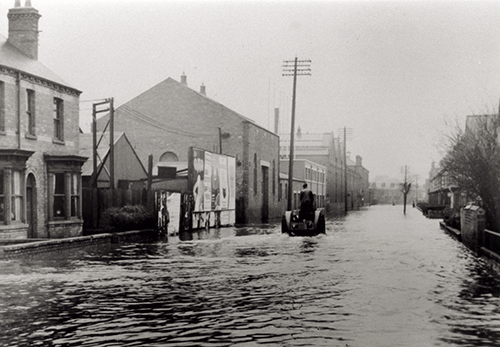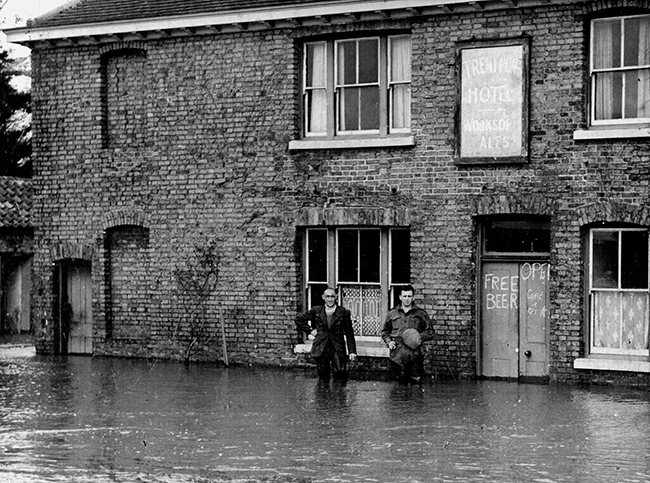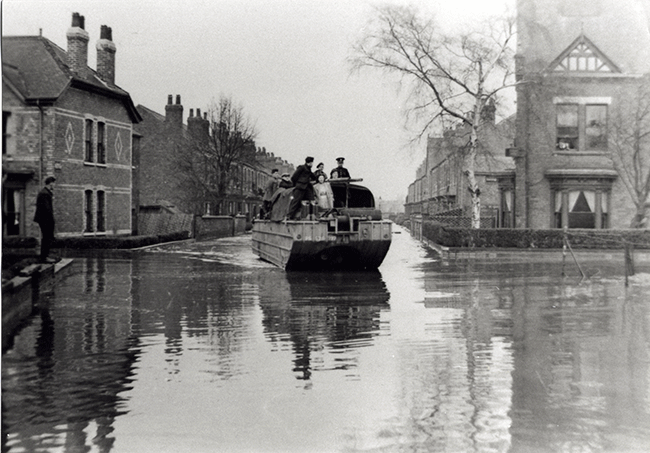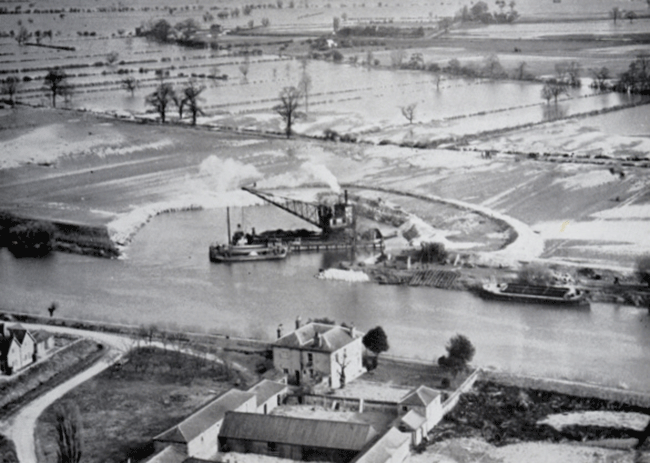Seventy years ago, Saturday March 22nd, 1947, was ‘Black Saturday’ for Gainsborough. It went down in the town’s history as the day when the River Trent overflowed its banks, pouring millions of gallons of flood water into the town and causing tremendous damage and inconvenience, also suffering to nearly half the population.
Never had such scenes been witnessed. The great flood of 1940, when the ‘News’ told the story of the ‘Epic of Melrose Road’ paled into insignificance in comparison, for great new areas of the town were involved, and to an extent never contemplated by the authorities who had the safety of the town in their hands – the Trent Catchment Board.
The quick thaw – the melting of two months of snow and ice (in itself a phenomenon) undoubtedly caused the Trent to overflow, first at Nottingham, and later, as the flood water surged along, in its lower reaches.

On Thursday evening the Trent was running very high, but there was at least three feet to spare at high tide at the then new Bowling Green flood bank, which was erected by the Trent Catchment Board after the 1940 flood. The board had seen to it that this bank was strong and high enough when compared to previous high tides to stand up against any flood, or so they thought. The board had also worked with the various businesses whose premises were alongside the River to keep the floods out. As part of the improvements a large barrier had been placed along the Great Northern Wharf, a flood bank had been erected in Humble Carr and barriers had been erected at all of the openings into Bridge Street. Messrs Rose Bros., Whittons the Trent Catchment Board and other concerns along the riverside had all assisted in raising barriers to the floods that were expected.
For three days the N.F.S., assisted by the works brigades of Marshalls, Roses and Newsums, pumped unceasingly to keep the sewers, whose penstocks were closed at the riverhead, clear of water.
The first real danger warning came on the Friday morning when the river started to pour over on the Notts side against the Railway Junction of the L.N.E.R. and also against the Trent Port hotel, near the Trent Bridge.
Ramper Road Closed
Within an hour or two the Ramper Road was flooded to a depth of two feet and the police of Lincs and Notts had to regulate the traffic, stopping all private cars. Several lorries became stuck and had to be hauled out and by teatime the road was closed.

This was shortly followed by news that the ballast of the railway embankments in the Beckingham area had been washed away by the floods, leaving the railway lines without support. This meant, that rail traffic, as well as road communication, was stopped with the track being undermined to such an extent that no trains could pass safely on either of the two converging lines.
Worse news was to come when at about 7-30pm the new flood bank beyond Newsum’s works gave way, and the water came rushing through, engulfing the L.N.E.R. Wharf and Pearsons Mill, sweeping through Edlington’s Works and spilling into Lea Road, flooding a number of streets in that area.
That evening saw the banks of the river crowded with numerous anxious onlookers as the tide brought great volumes of ‘fresh’ up the river. The overflowings on the Notts side continued unabated and by morning both side of Eight Arches bridge were flooded to a depth of five feet.
Saturday Mornings Tragedy
Early on Saturday morning the flood started to come into Gainsborough. The tide brought an avalanche of water with it that raged over the barriers erected all along Bridge Street, including Furley’s Wharf, and poured into the streets
bounded by Bridge Street and Trinity Street. All the area from Bridge Road to Hickman Street, even as far as Etherington Street were soon under water.
But the major tragedy of the whole morning was the overflowing at Rose Bros. works. Here every effort had been made to keep out the flood waters. The firm had battled for three days with the rising tide succeeding to keep it out until on the fateful morning when the heavy pressure broke down the fortifications and swept through the works.
Swirling out of the main entrances onto Ropery Road, it continued on its way through the houses, in at the front and out at the back, invading Balfour Street, Acland Street and Lincoln Street, and all the streets in that area as far as Fawcett Street and the Old Hall gardens.

At the same time the water overflowed further down the river. It went over the new flood bank from Bowling Green Lane to the Destructor and simply swamped the Haldane Street, Bowling Green Lane, George Street, Campbell Street and Ropery Road area. The flood careered on through almost the length of the Ropery Road district, into Lincoln Street, Alfred Street, Love Lane, and found a low spot in the Love Lane allotments.
As in 1940, it surged through this district, into Melrose Road, through the North Marsh Road, and found another low spot in the Morton Corner allotments. The swirling water filled up this small ‘reservoir’ and poured over the Morton cross roads like a torrent.
Filled up a Lake
It found a gap in the lake at Morton house and surged through the grounds like a river.
It turned over a car, swept people off their feet and soon flooded the Blyton road to a depth of three feet. Traffic was forced to detour back via Blyton, Pilham and Corringham.
In the meantime a very large part of the town was being flooded to a depth of three and four feet, and there were many incidents of courage and heroism in battling with the surging flood of water which swept through the town.
Soon there was another overflow at Morton Corner, where the water found an outlet and poured millions of gallons into the back part of the village. The Walkerith road was soon raging like a torrent, and this overflow continued for many hours, adding to the devastation in the Morton and Walkerith district.
The on Sunday morning there was a breach near the gymes, opposite Point Farm. The gap here being about 70 yards across, a breach in the bank never before seen in the history of Gainsborough.
The water simply cascaded down the river bank onto the low lying farms, and soon it was impossible to see the Gymes.

The flood tore great gaps into the land, surging forward with such fury that the people of Walkerith & West Stockwith were hurrying to remove what stock and possessions they could.
It was an unforgettable experience. It was Gainsborough and Districts ‘Black Saturday’.

Comments(12)
Bryan scott says
23rd March 2017 at 4:31 pmBeing born 11/04/47 and reading article it is strange to now know what my family had to undergo in Alfred street
Stu farrow says
10th May 2017 at 10:30 pmHi Andrew
Last year we bought no 4 ropery road and was just wondering if there is any old photos in circulation as we would love some in our hall way .
Thank you
Andrew Birkitt says
21st May 2017 at 8:41 amHi Stu
I would recommend you call in at the Centre and see as we do have pics of Ropery Road but they will be more general than specific houses.
Andy
Sandra says
24th March 2019 at 5:44 pmDid Walkerith flood ?
Andrew Birkitt says
20th May 2019 at 3:38 pmYes it did “Soon there was another overflow at Morton Corner, where the water found an outlet and poured millions of gallons into the back part of the village. The Walkerith road was soon raging like a torrent, and this overflow continued for many hours, adding to the devastation in the Morton and Walkerith district.”
Peter Foulston says
28th January 2020 at 11:40 pmMy dad lived in Nelson Street and worked at Rose Bros during and after WWII. Apparently, he had a go at driving the military “Duck” landing craft during the 1947 floods. He managed to demolish a wall whilst doing so!
B Lewin says
17th February 2020 at 11:00 pmIn January 1947 my family moved from our house in Walkerith whose large garden stretched down to the banks of the Trent . We often went to the ‘Gyme’ , reputably bottomless, where was the breach , to play or catch tadpoles .
As a child I was disappointed to miss the floods , our former home surprisingly was spared , but my Grandparents who were in their 70s, had a foot of water through their house which was opposite the Old Hall .
As the water subsided I visited and enjoyed a ride to Walkerith in one of the ‘ducks’ , army amphibious vehicles .
Robin mackenzie says
22nd February 2020 at 11:00 amMy family lived at5 acland st my grandparents at 62 64 ropery rd, howitt bakery the ovens collapsed on the Sunday morning ,we all moved upstairs with three dogs and a few cats.we stayed there for about three weeks.
Helen says
20th December 2020 at 8:32 pmMy father remembers this, he regaled me with the story of it and the aftermath on a walk the other day. He is now 86 and would have been 13 at the time. He lived up on the hill and remembers families taking in every displaced family from the flood area. Everyone pitched in.
Josephine says
28th December 2020 at 10:47 pmI know Morton was the main breach and that Spalford bank was overtopped. Do you know anything about the event down at Torksey and/or running down the Till?
Christine Caroline Farmery says
24th December 2021 at 3:02 pmHi Andrew
Very interesting article. I knew of the flooding but this put a lot more meat on the bones.
Do you happen to have/know any further information/photos regards a house called Ferry Hose, Trentside, Walkeringham. It was the opposite side to the ferry. I have been trying to find a photo and more information for approx. 10years. to no avail. I have a lot of photos of the ferry but never found one with the house in the background. I know the house stood there in 1931/1932 as my dad with family lived there. To go to School (Walkeringham) they all had to walk (quite a way ) from the house up and over the railway crossing. It was flooded that winter and they had to move everything upstairs, hence moved to Beckingham. I did track it down a number of years ago, obviously long gone but garden flowers still growing in what was the garden. Any information would be greatly appreciated.
T.I.A. Christine Farmery
Andrew Birkitt says
10th January 2022 at 9:13 amHi Christine
Unfortunately I don’t, there may be some more at the Heritage Centre but I know a friend of mine was looking into that as well. Best thing would be to email the research team on [email protected]
Recent posts
Events